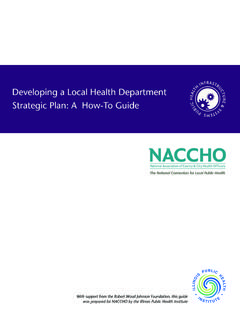Transcription of Perspectives on Strategic Planning - University of South ...
1 Perspectives on Strategic Planning in the Public Sector By Richard D. Young Strategic Planning is based on the premise that leaders and managers of public and nonprofit organizations must be effective strategists if their organizations are to fulfill their missions, meet their mandates, and satisfy constituents in the years ahead. (Bryson, 1995, p. ix). Introduction The literature is replete with coverage on the topic of Strategic Planning . Every nuance, every variance, every view, and every possible issue associated with Strategic Planning . purposes, definitions, methods, and implementation are covered in seemingly endless ways and detail.
2 Indeed, if an author were to write on the subject of Strategic Planning and add something of significance that was entirely new and innovative, such a chore would be difficult if not altogether improbable. Hence, this monograph attempts to take a rather straightforward and basic approach towards the subject matter and leave novelty to those who are more inclined, more inspired to act on the improbable. More precisely, this monograph will attempt to look concisely and substantively at Strategic Planning as it has been examined and written about by some of the leading experts of the present day.
3 In this way, while new trails may not be blazed, the topic of Strategic Planning will be given a succinct yet authoritative assessment. It is hoped that this approach will be informative and practical to both the academic as well as the casual reader. First, the background or history of Strategic Planning will be touched upon. Then from this historical context, several fundamental definitions by a mix of experts and authors will be offered, including some brief discussion from Mintzberg (1994) as to several schools of thought related to Strategic Planning . Next, Strategic Planning as a component of the Malcolm Baldrige criteria will be discussed with emphasis on how organizations establish objectives and action plans.
4 1. A model Strategic Planning process will then be outlined as based on principally Bryson (1995). This will be a rational, linear multi-step process that has been adapted by many experts and practitioners in the field of public management and administration as useful in achieving desired results in both Planning and implementation of public or nonprofit policy. Finally, a close look at the State of Texas and its Strategic Planning process . 1. The Baldrige National Quality Program is administered by the National Institute of Standards and Technology of the Department of Commerce. Information about the Baldrige program is available at.
5 1. called Texas Tomorrow will offer insights into the practical applications of Strategic Planning on a statewide basis. Background Strategic Planning is, in the military sense, an ancient science of warfare. Military campaigns and battles are typically referred to in historical literature as large-scale stratagems to confront and engage the enemy. However, Strategic Planning in the management and administrative context is a modern concept and process identifiable within both the corporate and public arenas. With regard to public Planning itself, municipal governments were the first to engage in putting together formal written documents to identify objectives and ways in which to achieve them.
6 The New York Municipal Research Authority formalized urban Planning techniques in the early part of the 20th century, setting goals, activities, schedules, and milestones in carefully ordered Planning documents. According to the American Planning Association, the first national conference on city Planning occurred in Washington, In 1916, Nelson P. Lewis published his seminal work entitled Planning of the Modern City. In 1928, the U. S. Department of Commerce, under then Secretary Herbert Hoover, administered what was called at the time the Standard City Planning Enabling Act. Another influential book on Planning was published in 1941 by Robert Walker, The Planning Function in Urban Government (See ).
7 Strategic Planning 's origins per se, as used in the public sector, can be traced to the late 1950s and early 1960s. The Department of Defense began to look for better and more useful ways to plan for its long-term needs while at the same time achieving cost savings. The advent of the Planning -Programming-Budgeting-System (PPBS) began what was to blossom into a series of varying Strategic Planning and budgeting systems. PPBS promised to do several things to improve federal governmental operations. Some of these anticipated improvements included: establishing long-range Planning goals and objectives.
8 Examining the costs and benefits of these expected ends; comparing and contrasting alternative activities to achieve agency goals and objectives; and, establishing multi-year projections for both executive and legislative consideration when considering annual budgets and appropriations (Young, 2001, p. 35). Many states followed suit using this new Strategic Planning approach, and as new adaptations came into being (Management by Objectives [c. 1970], Zero-Based Budgeting [c. 1977], and the Government Performance Act [c. 1993-present]), states also altered and perfected Strategic Planning methods and techniques.
9 Ultimately, Strategic Planning became prevalent, though varied, among many states. According to the literature, 2 states (and also many local governments) essentially agree that Strategic Planning is a process of developing a long-term plan to guide an organization, for example, a state agency, department or commission, towards a clearly 2. The following narrative of this section is largely excerpted from Young, 2001, pp. 61-66. 2. articulated mission, goals and objectives. It is a process of assessing where an organization is presently, ascertaining the challenges and opportunities that present themselves, and determining what destination is most desirable and how to get there.
10 Figure 1. Strategic Planning What are your capabilities? What do you want to accomplish? Mission Strengths &. Weaknesses Capabilities The Resources Fit Best course of action Opportunities &. Threats Needs of customers &. other stakeholders Competitors & allies Social, economic, political, & technological forces What is needed & feasible? Source: Bryan W. Barry (1997). Strategic Planning workbook for nonprofit organizations. Saint Paul, MN: Amherst Wilder Foundation, p. 7. The literature also suggests that states (including local governments) do in fact benefit from the Strategic Planning process mainly for the reason that the development of multi- year policy plans links present situations or circumstances with a more meaningful vision of the future.









